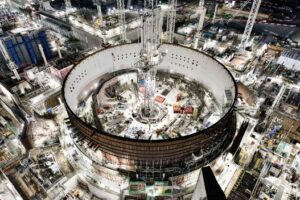It is tempting to think – given the record-breaking installations of solar PV in China, and on a different scale in Australia – that the world is well into the new age of solar.
But a striking new report from an independent source sheds new light on what awaits us. Importantly, it shows that the world has only just begun the age of solar, and has installed only a tiny fraction of what will follow.
The Energy Transition Outlook comes from DNV, a European-firm that provides independent assessments for both the fossil fuel industries (particularly oil and gas) and the renewable energy industry. You could say they have a foot in both camps.
That makes its detailed forecast for the impending energy transition striking. It holds no good news for oil – it says that industry production will peak in a few years and decline rapidly thereafter.
But it also suggests that the world’s energy consumption as a whole will peak within a decade – shedding forever the link between GDP and energy growth. And it says one of the biggest reasons for this is the efficiency of wind and solar. It notes that with fossil fuels, so much of the primary energy is wasted as heat.
And it predicts a big future for renewables, and solar in particular. That’s because wind and solar will be far cheaper than fossil fuels.
And in contrast to ultra-conservative forecasts from the likes of the International Energy Agency, DNV predicts renewables will make up 44 per cent of primary energy supply by 2050 and 85 per cent of electricity supply.
“Changes are coming so fast that it will surprise many people, even inside the industry”, one of the lead authors Sverre Alvik told Energy Post in an interview.
So here are a selection of our favourite graphs and a brief commentary with each:
 The first highlights just how early we are into the age of solar. See 2017, it’s barely a blip on the graph. According to DNV, the world is producing and consuming only a few “exajoules” of solar a year right now, but over the next decades that will increase 80-fold.
The first highlights just how early we are into the age of solar. See 2017, it’s barely a blip on the graph. According to DNV, the world is producing and consuming only a few “exajoules” of solar a year right now, but over the next decades that will increase 80-fold.
The various colours are the regions of the world…
The second graph (above) is the amount of solar capacity being installed each year. Here it is seen that the construction growth rate is well under way, but will rise four fold to more than 400GW by the early 2020s and steadily increase to 700GW by 2050.
The next few graphs illustrate the anticipated share of solar PV in the power mix in various countries, and two key markets for Australia – China and India. It is important to note here that these graphs illustrate not the share of capacity, but the share of output, which is far more significant..
So, in case anyone (federal government resources ministers or coal mining lobbies, for instance) tells you that the two biggest energy consumers – China and India – will be focused on coal, here’s a couple of graphs to shatter that illusion.
The first of these graphs is China (above), showing that coal-fired generation (in the blue) has likely already peaked. Even more strikingly, it suggests that coal generation in China would be all but gone by 2050, replaced largely by solar, wind, hydro and other sources.
Even more dramatically, from the solar point of view, is this graph (above) on India, which shows India relying on solar for more than half of its electricity generation from about 2030, and an overwhelming majority by 2050.
Coal generation does not grow much beyond the current levels – which will shatter the dreams of those who think it will rise by a factor of two or three. So, while the country hauls itself up to be one of the most dominant economies in the world – it will largely be renewables powered, and mostly solar-powered.
Indeed, this next graph shows the capacity additions that are expected over the next 30 years. There is no boom in coal, only in renewables. That’s something to think about for the people making decisions about financing proposed thermal coal export projects.
And this graph above is what the technology share looks like in 2050 in the electricity market. Coal’s share? Just 2.7 per cent.
This final graph (above) illustrates the decoupling of the growth in GDP and population, and energy use and emissions.
Sadly, however, those emission reductions are not enough to meet the Paris climate target of limiting global warming to “well below” 2°C target. DNV says if we are to get close, it will depend not just on the complete decarbonisation of electricity, but the electrification of nearly all energy uses, particularly transport.
And if we are to meet the 1.5°C target, that more and more scientists now admit may be essential to avoid the worse impact of global warming, then we are already on the point of exhausting the world’s carbon budget.
DNV puts this at within four years, an estimate supported by research by other groups such as Climate Analytics, the Potsdam Institute, and reinforced by former UNFCCC secretary Christiana Figueres during her visit to Australia this week.
Which means the world will overshoot, and then find a way back to reduce the levels of global warming.
The interview at Energy Post with Alvik and Paul Gardner, who led the storage component, is interesting reading. Gardner says storage is currently being held back by regulations that limit the role that networks can play, which may also be true in Australia.
But these two bits caught our attention, the first on whether a 100 per cent renewable energy is realistic:
“It is possible to build a secure system with a very high level of renewable energy”, says Gardner. “But in our projections we don’t quite get to 100%. We see quite a bit of ‘peaking’ gas generation to go with renewables by 2050. We have a lot of wind, a lot of solar and a lot of gas plant that spends a lot of time doing nothing. Even when we include the backup costs for the gas-fired power, this still looks attractive.”
And then:
“Gardner does add there is one thing that the model does not yet take into account, namely the effect that temporary surpluses of wind and solar power will have on the economics of renewables. ‘We have not yet shown what the impact is of that.’ However, he says, ‘we will also need to decarbonise heat, so it makes sense to store the surplus renewable energy, for example to heat water with it or to convert it into gas, to be used for heating. It is not yet clear what the most economic route will be’.”
And, finally, because of the restrained demand, overall investment in energy won’t have to increase, despite the transition.
“Major investments need to be made”, Gardner tells Energy Post, “but the amount of money the world spends on energy does not change much. The total number will be lower relative to GDP. That’s a pleasant surprise: we can afford the transition.”
Tune into the latest episode of Solar Insiders for an entertaining and informative discussion about the main news of the week and significant issues in the Australian solar industry.
















